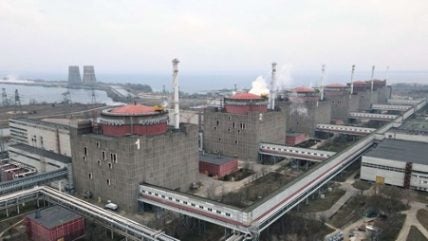
Ukraine’s Zaporizhzhya Nuclear Power Plant temporarily lost the connection to its sole remaining 750 kV off-site power line on 23 May owing to a reported short-circuit, leaving it reliant on a single back-up line for more than three hours, International Atomic Energy Agency director general Rafael Grossi said during the IEA’s latest update (number 229) on the situation in war-torn Ukraine.
The disconnection of the 750 kV Dniprovska line once again underlines the extremely precarious nuclear safety and security situation at the ZNPP during the armed conflict. It occurred at 1:31pm local time around six km away from the ZNPP’s 750 kV open switchyard, in Russian-controlled territory. The ZNPP informed the IAEA experts stationed at the site that it was caused by a short-circuit, without providing further details. The line was re-connected at 4:49 pm.
The event also amplifies concerns around attacks on the electrical power infrastructure elsewhere in Ukraine during the week of 13 May, as indicated in the IAEA’s previous report, Update 228, highlighting the risk to the ZNPP as well as to the other operating nuclear power plants in the country. When the 750 kV line was disconnected, ZNPP received external electricity from its only 330 kV back-up line. It is particularly vulnerable to such disruptions. Before the conflict, the plant had four 750 kV and six 330 kV lines available.
“For Europe’s largest nuclear power plant to depend on one or two power lines is a deep source of concern and clearly not sustainable. Our concerns also extend to the operating NPPs across Ukraine, where a disruption to off-site power supplies could have very serious implications for nuclear safety,” director general Grossi said.
Earlier in the week of 20 May, ZNPP also informed the IAEA of a drone attack on a transport workshop in the nearby industrial area, reportedly causing some damage but no casualties. If confirmed, that strike, around four km from the ZNPP site, would further underline the continuing military-related risks facing this major nuclear facility, following April’s drone attacks targeting the site itself.
In addition, the IAEA team of experts stationed at the ZNPP have continued to hear explosions at various distances from the plant over the past week.
“For the outside world, the situation at the Zaporizhzhya Nuclear Power Plant may have appeared relatively calm in recent weeks, since the drone attacks on the site confirmed by our experts in mid-April. But this is not the way we see the situation on the ground. The stark reality is one of constant danger. The nuclear safety and security situation at the site remains extremely vulnerable,” said director general Grossi.
Maintenance
IAEA experts present at the Khelmnytskyy, Rivne and South Ukraine NPPs and the Chornobyl site reported that nuclear safety and security is being maintained despite the effects of the ongoing conflict, including air raid alarms on several days in recent weeks. Two of the four reactor units at the Rivne NPP have completed refuelling activities and are expected to resume generating power in the near future, while the maintenance and refuelling activities at one unit at the South Ukraine NPP are progressing according to schedule.




